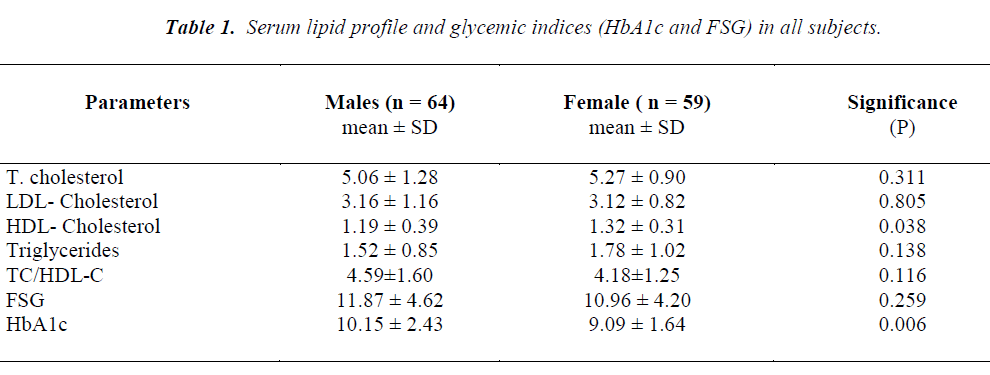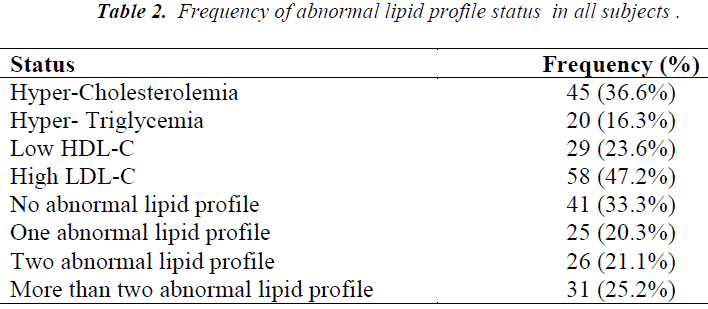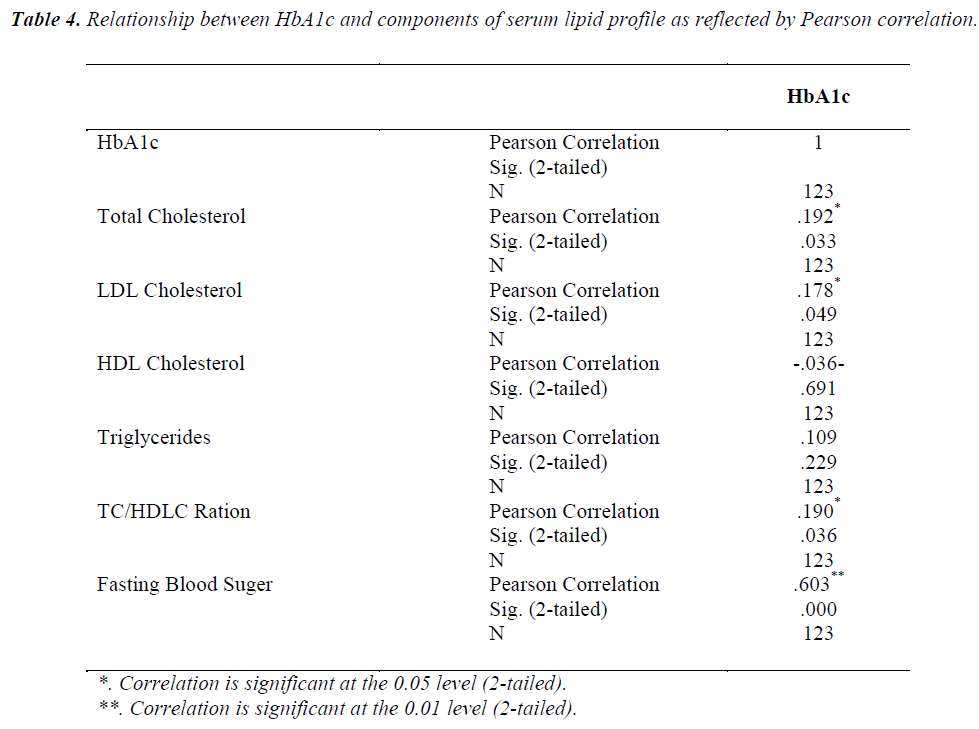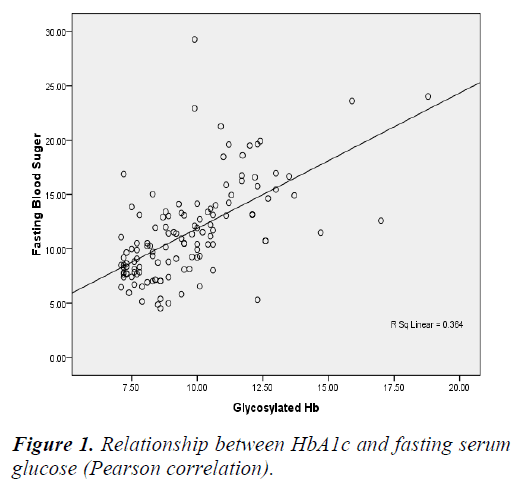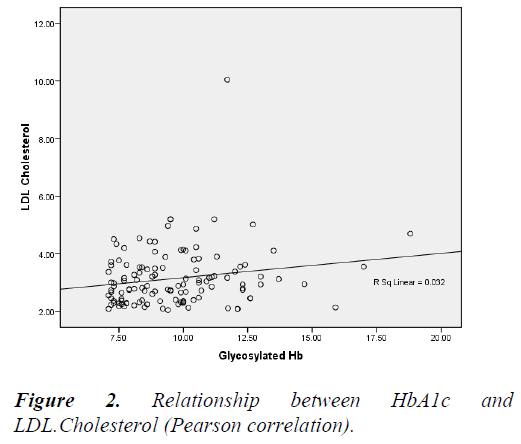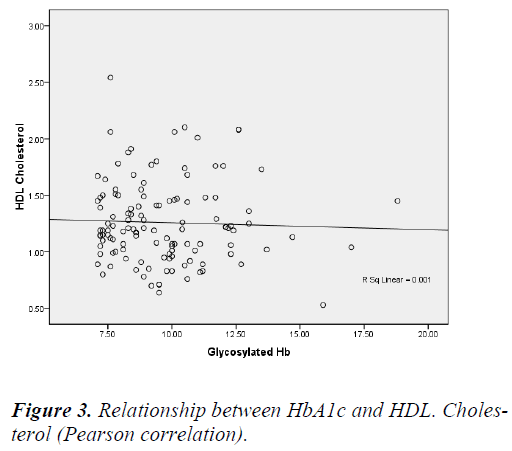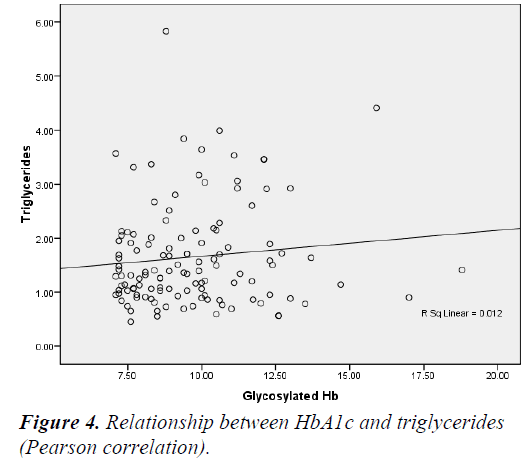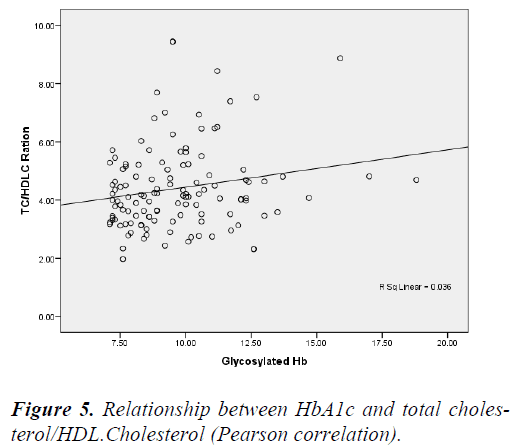ISSN: 0970-938X (Print) | 0976-1683 (Electronic)
Biomedical Research
An International Journal of Medical Sciences
- Biomedical Research (2014) Volume 25, Issue 2
Serum lipid profile and glycated hemoglobin status in Omani patients with type2 diabetes mellitus attending a primary care polyclinic.
Senior Lab Technologist, Laboratory Department, Ibri Polyclinic, Ministry of Health, Oman
Accepted date: January 08 2014
This is a cross-sectional study that was carried out from 1st September 2012 to 31st December 2012, at Ibri Polyclinic, Oman To assess the relationship between glycemic control (as reflected by glycated hemoglobin; HbA1c) and serum lipid profile in type 2 diabetic patients attending a primary care polyclinic, Oman, and included 123 type 2 diabetic patients (64 males and 59 females). The mean ±SD of age was 50.8 ± 11.5 years for males and 54.3 ± 10.1 years for females. During their regular visits to the clinic for clinical follow up, venous blood samples were collected from all subjects after at least 8 hours fasting. Blood specimens were collected into EDTA tubes for HbA1c and in Serum Separator Tube for fasting glucose (FSG) and lipid profile measurement. The data were evaluated by SPSS statistical package version 16. The results were analyzed using independent samples t-test (2-tailed), Pearson’s correlation. There were no significant differences in the mean values of the different parameters between males and females except the significantly lower mean HbA1c and higher mean HDL-C in females. This may reflect better adherence to diabetic management by females as well as the known higher HDL-C in females due to gender effect particularly estrogen effect during reproductive age. Also, the glycemic state and lipid profile were better in those aged >50 year than those aged <50 year. Meanwhile, hypercholesterolemia was found in 45 (36.6%) patients, hypertriglyceriemia was found in 20 (16.3%) patients, decreased HDL-C was found in 29 (23.6%), and increased LDL-C was found in 58 (47.2%) patients, Forty-one (33.3%) patients had no abnormal lipid profile parameters, 25 (20.3%) patients had only one abnormal lipid profile parameters, 26 (21.1%) patients had two abnormal lipid profile parameters, and 31 (25.2%) patients had more than two abnormal lipid profile parameters. According to Diabetes Control and Complications Trial/National Glycohemoglobin Standardization Program (DCCT/NGSP), 17 (25%) males out of 64 and 28 (41.6%) females out of 59 were dyslypidemic. Dyslipidemia was improved in many diabetics with better glycemic control as reflected by HbA1c. Hence, achieving the target of HbA1c will contribute in improving the lipid state, and hence may lessen the diabetic complications in type 2 diabetic patients.
Keywords
Diabetes mellitus, glycated hemoglobin (HbA1c), lipid profile
Introduction
Diabetes mellitus is a metabolic disease characterized by hyperglycaemia resulting from either insulin deficiency or/and insulin resistance. It causes about 5% of all deaths globally each year. The World Health Organization (WHO) report in 2010 estimates that the number of diabetic patients in Oman will increase up to 190% over the next 20 years, from 75,5000 in 2000 to 217,000 in 2025 [1].
The chronic hyperglycemia of diabetes can damage several body organs as a consequence of microvascular and macrovascular complications [2,3]. The macrovascular complications of diabetes include cardiovascular disease (CVD) such as heart disease and stroke, which are the cause of death in 50% of diabetics [4,5]. On the other hand, microvascular complications of diabetes include diabetic nephropathy, neuropathy, and retinopathy [6]. The cardiovascular risk of diabetes increases further if diabetes is associated with dyslipidemia. However, this risk can be reduced by good management and control of both hyperglacymia and dyslipidemia [7,8].
Glycated hemoglobin (HbA1c) is routinely measured to check the glycemic control over a preceding 8-12 weeks of time [9]. It is used as an indicator for the state of glycemic control, progression of the disease and development of complications in diabetic patients [10,11]. Regardless of dyslipidemia, high HbA1c is now considering as an independent risk factor for CVD. A study done by Selvin et.al [12] revealed that each 1% increase in absolute HbA1c value in diabetic patients increased the risk of CVD by 18 %. One of the major risk factors of CVD in type 2 diabetic mellitus is dyslipidemia. The indicators of diabetic dyslipidemia include elevated level of triglycerides and LDL-C and low HDL-C. The changes in lipid parameters in diabetes mellitus are due to increased free fatty acid flux secondary to insulin resistance [13–16]. Positive relationship between HbA1c and CVD has been demonstrated in non-diabetic cases even within normal range of HbA1c [17-20].
The aim of this study was to find out the relationship between glycemic control as reflected by HbA1c and serum lipid profile in type 2 diabetic patients attending Ibri Polyclinic, Ibri, Oman.
Patients and Methods
A total of 124 type 2 diabetic patients (65 males and 59 females) attending the Diabetic Clinic of Ibri Polyclinic, Ibri, Oman from September 2012 to December 2012 were included in this study. Venous blood samples were collected from all the subjects after at least 8 hours fasting. Blood specimens were collected into EDTA tubes for HbA1c and in Serum Separator Tube for fasting glucose (FSG) and lipid profile measurement. All the biochemical analyses were performed in the Laboratory Department, Ibri Polyclinic using an Hitachi 902. Serum was used for analyzing lipid profile, which includes total cholesterol (TC) by enzymatic (CHOD-PAP), HDL-cholesterol (HDL-C) by homogeneous enzymatic (HDL-C plus third generation), and triglycerides (TAG) by enzymatic (GPOPAP). LDL-cholesterol (LDL-C) was calculated by Friedwald and Frederickson formula and atherogenic risk ratio of TC/HDL-C by dividing TC by HDL-C. FSG was measured by enzymatic (GOD-PAP) method and HbA1c by turbidimetric inhibition standardized method according to International Federation of Clinical Chemistry (IFCC) and transferable to Diabetes Control and Complications Trial/National Glycohemoglobin Standardization Program (DCCT/NGSP) [21].
The data were statistically evaluated by SPSS statistical package version 16.0. Independent sample t-test (2-tailed) was used to compare means of different parameters. Pearson’s correlation test was performed to examine various correlations. The value of HbA1c was given as percentage of total hemoglobin (%) and values of all other parameters were given in mmol/l. All values are expressed as mean ± standard error of mean. The results were considered significant when P < 0.05.
Results
One hundred and twenty three consecutive patients with type 2 diabetes mellitus were followed (64 males, 59 females). The mean age of males and females was 50.8 ± 11.5 and 54.3 ±10.1 years, respectively. The mean value of HbA1c, LDL, TC/HDL were higher in male in comparison to female patient's and it was significant for HbA1c.Whereas, the mean values of total cholesterol (TC), L, HDL-C, Triglycerides and Fasting Blood Sugar (FBG) were higher in female patients than male.
Discussion
In the present study, we have evaluated the pattern of lipid profile in type 2 diabetic patients and its correlation with HbA1c. The levels of HbA1c differ significantly between male and female subjects. On the other hand, there was no significant difference in TC, TAG, LDL-C, TC/HDL-C ratio and FSG between the male and female patients. The level of HDL-C was significantly higher in female as compared to male type 2 diabetics. This may reflect better adherence to diabetic management by females as well as the known higher HDL-C in females due to gender effect particularly estrogen effect during reproductive age. This study also reveals moderate high prevalence of hypercholesterolemia, hypertriglyceridemia, high LDL-C and low HDL.C levels. The main lipid abnormality in our diabetic patients was high LDL-C levels. The levels of HbA1c, TC, TAG, TC/HDL-C and FSG were significantly different between those aged ≥50 years and <50 years old patients. Whereas mean HDL-C level was slightly higher in patients of ≥50 years compared with those of <50 years old, however the difference was not statistically significant. This may also reflect better glycemic control and patients’ adherence to diabetic management. Similarly, study done by Al Lawati et al [22], reported that the younger Omani type 2 diabetics exhibited worse glycemic state compared to older patients.
A highly significant correlation between HbA1c and FSG was noted in this study. Similarly, significant correlations between HbA1c and TC, LDL-C, and TC/HDL-C ratio were observed. In the prospective cohort study included 418 type 2 diabetics with follow-up until the appearance of cardiovascular disorders, it was observed that the main lipid predictor of vascular events was mean TC/HDL-C ratio with the conclusion to use this ratio as a guide for treatment of diabetic dyslipidemia [23]. In this regard it is worth to state that apo-B containing particles and small LDL-C particles are increased in diabetes and these metabolic indicators are indirectly reflected by TC/HDL-C ratio rather than LDL-C alone. The significant association between HbA1c with TC/HDL-C ratio in the present study suggests the importance of glycemic control reflects an improved lipid status.
In conclusion, a significant correlation exists between HbA1c and lipid profile.The better the glycemic control as reflected by HbA1c the better would be the lipidemic state. Achieving the target in HbA1c will contribute in improving the lipid state, and hence may lessen the diabetic complications in type 2 diabetic patients. HbA1c can be used as an indicator of glycemic control as well as a predictor of lipidemic state in type 2 diabetics.
Acknowledgments
The author is thankful to Dr. Waadallh Sharef, Senior Consultant and Head of Chemical Pathology Lab, Royal Hospital, Muscat and Dr.Manal Al.Kindiy , Senior Consultant, Chemical Pathology Lab, Royal Hospital and Dr.Buthina Al.Bahri , Senior Consultant , Chemical Pathology Lab, Royal Hospital and Dr. Hala Al.Hinai , Sultan Qaboos University Hospital, for their support and cooperation during the course of this study.
References
- Editorial. Type 2 diabetes – time to change our approach. Lancet 2010; 375(9733): 2193
- The Expert Committee on the Diagnosis and Classification of Diabetes Mellitus: Follow-up report on the diagnosis of diabetes mellitus. Diabetes Care 2003; 26:3160-3167.
- UK Prospective Diabetes Study (UKPDS). VIII. Study design, progress and performance. Diabetologia 1991; 34: 877-890.
- Diabtes. http://.who.int/mediacentre/factsheets/fs312/en/index.html (accessed Nov 2013).
- Glycosylaed Haemoglobin, HbA1C. hptt:// clinlabnavigator. com/test-interpretations/haemoglobina1c.html?letter=h (accessed Nov 2013).
- Michael J, Fowler MD. Microvascular and macrovascular complications of diabetes. Clinical Diabetes 2008; 28: 277-82.
- Haffner SM, Lehto S, Ronnemaa T, Pyorala K, Laakso M. Mortality from coronary heart disease in subjects with type 2 diabetes and in nondiabetic subjects with and without prior myocardial infarction. N Engl J Med 1998; 339: 229-234.
- Windler E. What is the consequence of an abnormal lipid profile in patients with type 2 diabetes or the metabolic syndrome? Atheroscler Suppl 2005; 6: 11-14.
- Delamater AM. Clinical Use of Hemoglobin A1c to Improve Diabetes Management. Clinical Diabetes 2006; 24: 6-8.
- Feldt-Rasmussen B. Is there a need to optimize glycemic control in hemodialyzed diabetic patients? Kidney Int 2006; 70: 1392–1394.
- Stolar M, Glycemic control and complications in type 2 diabetes mellitus. Am J Med 2010; 123(3 Suppl): S3-11.
- Selvin E, Marinopoulos S, Berkenblit G, Rami T, Brancati FL, Powe NR, et al. Meta-analysis: glycosylated hemoglobin and cardiovascular disease in diabetes mellitus. Ann Intern Med 2004; 14: 421-431.
- Taskinen MR. Diabetic dyslipidaemia: from basic research to clinical practice. Diabetologia 2003; 46: 733-749.
- Krauss RM and Siri PW. Dyslipidemia in type 2 diabetes. Med Clin North Am 2004; 88: 897-909.
- Del Pilar Solano M, Goldberg RB. Management of diabetic dyslipidemia. Endocrinol Metab Clin 2005; 34: 1-25.
- Chahil TJ, Ginsberg HN. Diabetic dyslipidemia. Endocrinol Metab Clin 2006; 35: 491-510.
- Khaw KT, Wareham N, Bingham S, Luben R, Welch A, Day N. Association of hemoglobin A1c with cardiovascular disease and mortality in adults: the European Prospective Investigation in to Cancer in Norfolk. Ann Intern Med 2004; 141: 413-420.
- Hill JB, Kessler G. An automated determination of glucose utilizing a glucose oxidase-peroxidase system. J Lab Clin Med 1961; 57: 970-980.
- Deeg R, Ziegenhorn J. Kinetic enzymatic method for automated determination of total cholesterol in serum. Clin Chem 1983; 29: 1798-802.
- Bucolo G, David H. Quantitative determination of serum triglycerides by the use of enzymes. Clin Chem 1973; 19: 476-482.
- Karl J, Burns G, Engel WD, Finke A, Kratzer M, Rollinger W, et al. Development and standardization of a new immunoturbidimetric assay HbA1c Assay. Klin Lab 1993; 39: 991-996.
- Al lawati JA, Barakat MN, Al Maskari M, Elsayed MK, Al Lawati AM, Mohammed JA. HbA1c levels among primary healthcare patients with type 2 diabetes in Oman. Oman Med J 2012; 27: 465-470.
- Gimeno-Orna JA, Faure-Nogueras E and Sancho-Serrano MA. Usefulness of total cholesterol/HDLcholesterol ratio in the management of diabetic dyslipidaemia. Diabet Med 2005; 22: 26-31.
